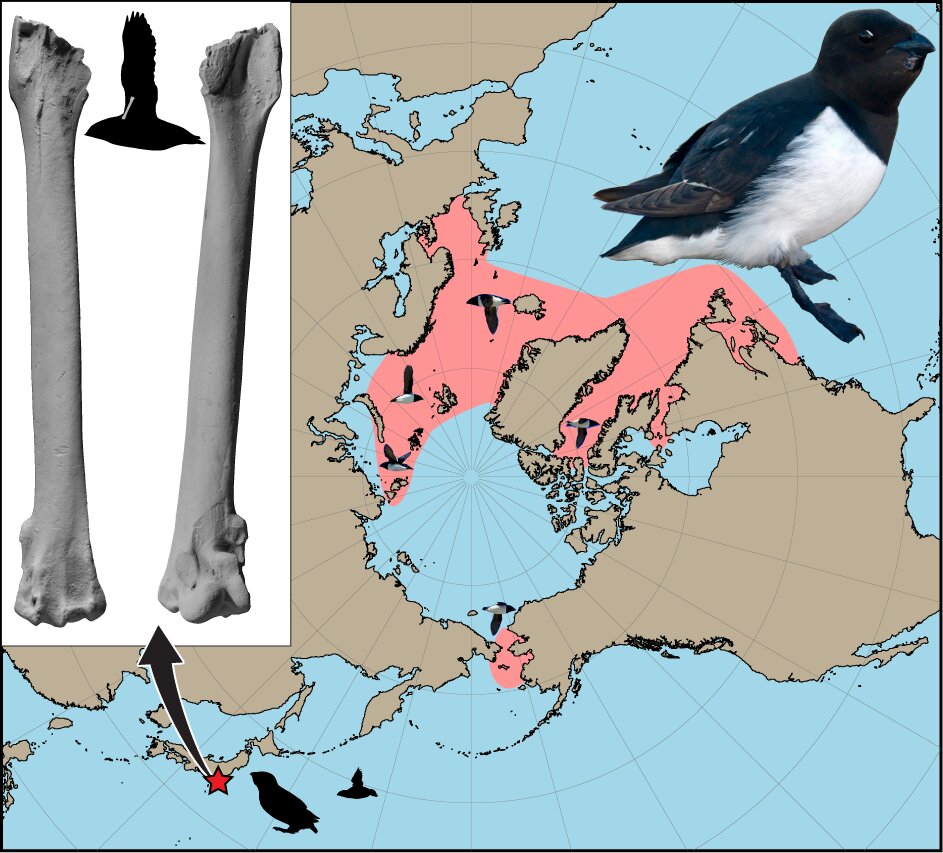Post by Eaglehawk on Jan 22, 2020 5:56:21 GMT
Little Auk (Dovekie) - Alle alle
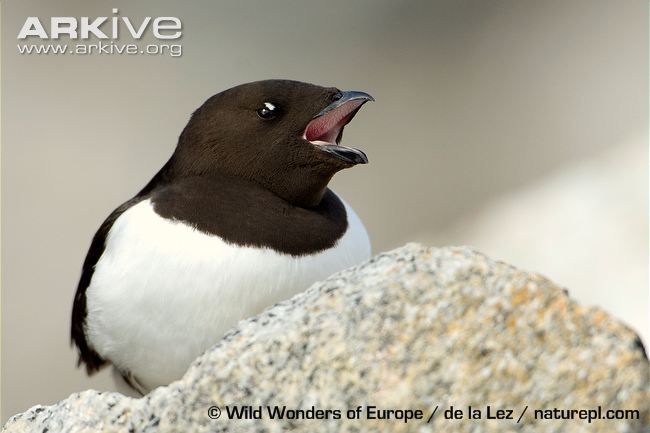
Scientific classification
Kingdom: Animalia
Phylum: Chordata
Class: Aves
Order: Charadriiformes
Family: Alcidae
Genus: Alle
Species: Alle alle
The little auk, or dovekie (Alle alle), is a small auk, the only member of the genus Alle. It breeds on islands in the high Arctic. There are two subspecies: A. a. alle breeds in Greenland, Iceland, Novaya Zemlya and Spitsbergen, and A. a. polaris on Franz Josef Land.
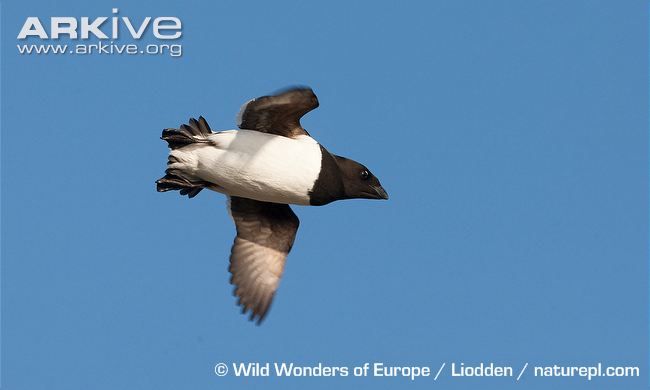
Morphology and behaviour
This is the only Atlantic auk of its size, half the size of the Atlantic Puffin at 19–21 cm in length, with a 34–38 cm wingspan. Adult birds are black on the head, neck, back and wings, with white underparts. The bill is very short and stubby. They have a small rounded black tail. The lower face and fore neck become white in winter.
The flight is direct, with fast whirring wing beats due to the short wings. These birds forage for food like other auks by swimming underwater. They mainly eat crustaceans, especially copepods, but also other small invertebrates along with small fish. They collect in large swarms before leaving their breeding rocks to head out to sea for food as well as when they return.
Little auks produce a variety of twitters and cackling calls at the breeding colonies, but are silent at sea.
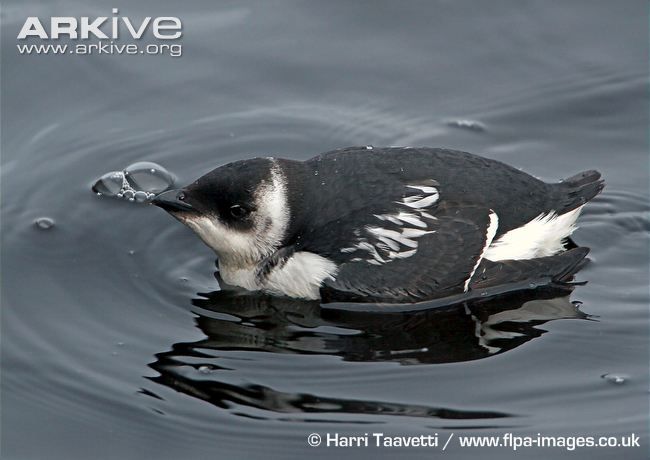
Habitat and range
Their breeding habitat is coastal mountainsides, where they have large colonies. They nest in crevices or beneath large rocks, usually laying just one egg. They move south in winter into northern areas of the north Atlantic. Late autumn storms may carry them south of their normal wintering areas, or into the North Sea. The species is also commonly found in the Norwegian Sea.
In the book, The Long Winter, Laura Ingalls Wilder writes of her father finding a small bird that looked just like a Great Auk hidden in a haystack after an early October blizzard when the family lived near De Smet, South Dakota around 1880. The family never did find out what it was, but it appears to have been a little auk, blown south by the autumn blizzard.
The glaucous gull and the Arctic Fox are the main predators on little auks, and, in some cases, the Polar Bear has also been reported to feed on their eggs.
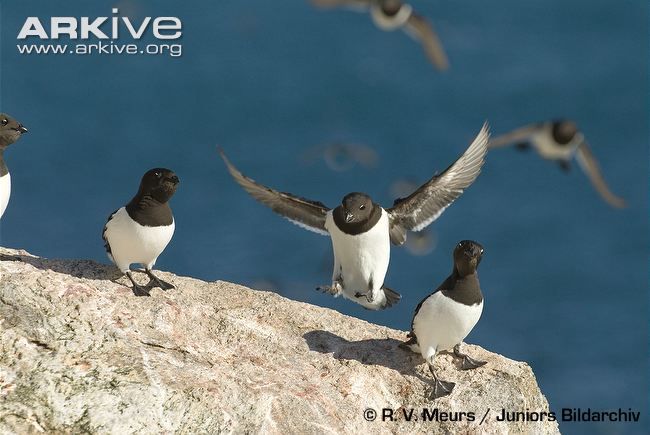
Conservation
Large numbers of little auks have been killed in several oil-spill incidents. but climate changes (warming) in Southern Greenland and Iceland seems to be the reason for the decreasing populations there.
Arctic's 'Penguins of the North' Find Workaround to Climate Change
New study finds that little auks are adjusting their food supply, raising questions of adaptation.

Little auks returning from sea to nest after feeding on copepods.
Brian Clark Howard
National Geographic
PUBLISHED JANUARY 12, 2015
What's New: The latest research on little auks, sometimes called "penguins of the north," reveals a surprising response to a rapidly warming Arctic: The birds make up for food lost to the effects of climate change by catching prey that were stunned by the cold water running off melting glaciers—another effect of climate change.
The study, published Monday in the journal Global Change Biology, is the first to examine the feeding habits of little auks as Arctic ice is lost. Scientists watched the birds in Franz-Josef Land, off the northern coast of Russia, during an expedition supported by the National Geographic Society.
Since 2005, the auks' water has become essentially ice-free in summer, reducing the numbers of tiny animals known as zooplankton, a key food source for the auks. Zooplankton normally congregated around sea ice, but now the birds have shifted to eating zooplankton that are stunned—and thus easier to catch—by cold water running off glaciers melting on land.
The shift hasn't been entirely seamless. Little auk chicks have been growing just as quickly as they did before 2005, but the adults' body mass has dropped an average of 4 percent since the early 1990s. That might not sound like much, but "we don't know what the weight loss is that would really harm them," says Enric Sala, a co-author of the study and a National Geographic explorer-in-residence.
Why It Matters: Little auks are considered especially vulnerable to climate change. The birds are often considered an indicator species of the Arctic, raising red flags for ecological changes.
"It's good news that the little auks are adapting now," Sala says, "but because the system is changing continuously, we don't know how long they will be able to keep up."
The birds also play an important role in the Arctic ecosystem, so other species could be affected by changes in little auks.
The Big Picture: To date, the Arctic has warmed twice as fast as lower latitudes have. The Arctic will be essentially free of summer sea ice by the 2030s, with drastic implications for species from seabirds to polar bears, according to the Intergovernmental Panel on Climate Change. (Similar forces are at work around Antarctica.)
Some Arctic species may go extinct, scientists have warned, but precisely how individual species will respond is largely unknown and will probably hold some surprises, as this new paper suggests.
What's Next: The scientists estimate that all continental glaciers will disappear from Franz-Josef Land within about 180 years, although meltwater could decrease significantly before that. As that happens, it's unclear if the birds will be able to find enough food.
"Ultimately, there is only one thing we can do for little auks, polar bears, and everything else that is affected," says Sala. "That's to reduce emissions of greenhouse gases."
news.nationalgeographic.com/news/2015/01/150112-little-auks-global-warming-climate-change-environment/
Arctic warming: nonlinear impacts of sea-ice and glacier melt on seabird foraging
David Grémillet, Jérôme Fort, Françoise Amélineau, Elena Zakharova, Tangi Le Bot, Enric Sala and Maria Gavrilo
Article first published online: 12 JAN 2015
DOI: 10.1111/gcb.12811
Abstract
Arctic climate change has profound impacts on the cryosphere, notably via shrinking sea-ice cover and retreating glaciers, and it is essential to evaluate and forecast the ecological consequences of such changes. We studied zooplankton-feeding little auks (Alle alle), a key sentinel species of the Arctic, at their northernmost breeding site in Franz-Josef Land (80°N), Russian Arctic. We tested the hypothesis that little auks still benefit from pristine arctic environmental conditions in this remote area. To this end, we analysed remote sensing data on sea-ice and coastal glacier dynamics collected in our study area across 1979–2013. Further, we recorded little auk foraging behaviour using miniature electronic tags attached to the birds in the summer of 2013, and compared it with similar data collected at three localities across the Atlantic Arctic. We also compared current and historical data on Franz-Josef Land little auk diet, morphometrics and chick growth curves. Our analyses reveal that summer sea-ice retreated markedly during the last decade, leaving the Franz-Josef Land archipelago virtually sea-ice free each summer since 2005. This had a profound impact on little auk foraging, which lost their sea-ice-associated prey. Concomitantly, large coastal glaciers retreated rapidly, releasing large volumes of melt water. Zooplankton is stunned by cold and osmotic shock at the boundary between glacier melt and coastal waters, creating new foraging hotspots for little auks. Birds therefore switched from foraging at distant ice-edge localities, to highly profitable feeding at glacier melt-water fronts within

Scientific classification
Kingdom: Animalia
Phylum: Chordata
Class: Aves
Order: Charadriiformes
Family: Alcidae
Genus: Alle
Species: Alle alle
The little auk, or dovekie (Alle alle), is a small auk, the only member of the genus Alle. It breeds on islands in the high Arctic. There are two subspecies: A. a. alle breeds in Greenland, Iceland, Novaya Zemlya and Spitsbergen, and A. a. polaris on Franz Josef Land.

Morphology and behaviour
This is the only Atlantic auk of its size, half the size of the Atlantic Puffin at 19–21 cm in length, with a 34–38 cm wingspan. Adult birds are black on the head, neck, back and wings, with white underparts. The bill is very short and stubby. They have a small rounded black tail. The lower face and fore neck become white in winter.
The flight is direct, with fast whirring wing beats due to the short wings. These birds forage for food like other auks by swimming underwater. They mainly eat crustaceans, especially copepods, but also other small invertebrates along with small fish. They collect in large swarms before leaving their breeding rocks to head out to sea for food as well as when they return.
Little auks produce a variety of twitters and cackling calls at the breeding colonies, but are silent at sea.

Habitat and range
Their breeding habitat is coastal mountainsides, where they have large colonies. They nest in crevices or beneath large rocks, usually laying just one egg. They move south in winter into northern areas of the north Atlantic. Late autumn storms may carry them south of their normal wintering areas, or into the North Sea. The species is also commonly found in the Norwegian Sea.
In the book, The Long Winter, Laura Ingalls Wilder writes of her father finding a small bird that looked just like a Great Auk hidden in a haystack after an early October blizzard when the family lived near De Smet, South Dakota around 1880. The family never did find out what it was, but it appears to have been a little auk, blown south by the autumn blizzard.
The glaucous gull and the Arctic Fox are the main predators on little auks, and, in some cases, the Polar Bear has also been reported to feed on their eggs.

Conservation
Large numbers of little auks have been killed in several oil-spill incidents. but climate changes (warming) in Southern Greenland and Iceland seems to be the reason for the decreasing populations there.
Arctic's 'Penguins of the North' Find Workaround to Climate Change
New study finds that little auks are adjusting their food supply, raising questions of adaptation.

Little auks returning from sea to nest after feeding on copepods.
Brian Clark Howard
National Geographic
PUBLISHED JANUARY 12, 2015
What's New: The latest research on little auks, sometimes called "penguins of the north," reveals a surprising response to a rapidly warming Arctic: The birds make up for food lost to the effects of climate change by catching prey that were stunned by the cold water running off melting glaciers—another effect of climate change.
The study, published Monday in the journal Global Change Biology, is the first to examine the feeding habits of little auks as Arctic ice is lost. Scientists watched the birds in Franz-Josef Land, off the northern coast of Russia, during an expedition supported by the National Geographic Society.
Since 2005, the auks' water has become essentially ice-free in summer, reducing the numbers of tiny animals known as zooplankton, a key food source for the auks. Zooplankton normally congregated around sea ice, but now the birds have shifted to eating zooplankton that are stunned—and thus easier to catch—by cold water running off glaciers melting on land.
The shift hasn't been entirely seamless. Little auk chicks have been growing just as quickly as they did before 2005, but the adults' body mass has dropped an average of 4 percent since the early 1990s. That might not sound like much, but "we don't know what the weight loss is that would really harm them," says Enric Sala, a co-author of the study and a National Geographic explorer-in-residence.
Why It Matters: Little auks are considered especially vulnerable to climate change. The birds are often considered an indicator species of the Arctic, raising red flags for ecological changes.
"It's good news that the little auks are adapting now," Sala says, "but because the system is changing continuously, we don't know how long they will be able to keep up."
The birds also play an important role in the Arctic ecosystem, so other species could be affected by changes in little auks.
The Big Picture: To date, the Arctic has warmed twice as fast as lower latitudes have. The Arctic will be essentially free of summer sea ice by the 2030s, with drastic implications for species from seabirds to polar bears, according to the Intergovernmental Panel on Climate Change. (Similar forces are at work around Antarctica.)
Some Arctic species may go extinct, scientists have warned, but precisely how individual species will respond is largely unknown and will probably hold some surprises, as this new paper suggests.
What's Next: The scientists estimate that all continental glaciers will disappear from Franz-Josef Land within about 180 years, although meltwater could decrease significantly before that. As that happens, it's unclear if the birds will be able to find enough food.
"Ultimately, there is only one thing we can do for little auks, polar bears, and everything else that is affected," says Sala. "That's to reduce emissions of greenhouse gases."
news.nationalgeographic.com/news/2015/01/150112-little-auks-global-warming-climate-change-environment/
Arctic warming: nonlinear impacts of sea-ice and glacier melt on seabird foraging
David Grémillet, Jérôme Fort, Françoise Amélineau, Elena Zakharova, Tangi Le Bot, Enric Sala and Maria Gavrilo
Article first published online: 12 JAN 2015
DOI: 10.1111/gcb.12811
Abstract
Arctic climate change has profound impacts on the cryosphere, notably via shrinking sea-ice cover and retreating glaciers, and it is essential to evaluate and forecast the ecological consequences of such changes. We studied zooplankton-feeding little auks (Alle alle), a key sentinel species of the Arctic, at their northernmost breeding site in Franz-Josef Land (80°N), Russian Arctic. We tested the hypothesis that little auks still benefit from pristine arctic environmental conditions in this remote area. To this end, we analysed remote sensing data on sea-ice and coastal glacier dynamics collected in our study area across 1979–2013. Further, we recorded little auk foraging behaviour using miniature electronic tags attached to the birds in the summer of 2013, and compared it with similar data collected at three localities across the Atlantic Arctic. We also compared current and historical data on Franz-Josef Land little auk diet, morphometrics and chick growth curves. Our analyses reveal that summer sea-ice retreated markedly during the last decade, leaving the Franz-Josef Land archipelago virtually sea-ice free each summer since 2005. This had a profound impact on little auk foraging, which lost their sea-ice-associated prey. Concomitantly, large coastal glaciers retreated rapidly, releasing large volumes of melt water. Zooplankton is stunned by cold and osmotic shock at the boundary between glacier melt and coastal waters, creating new foraging hotspots for little auks. Birds therefore switched from foraging at distant ice-edge localities, to highly profitable feeding at glacier melt-water fronts within



